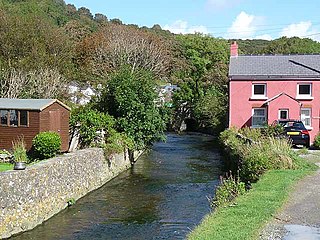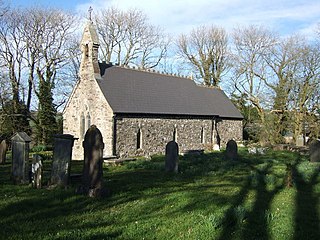History
Solva Woollen Mill claims to be the oldest working woollen mill in Pembrokeshire. There were 26 woollen mills in Pembrokeshire in 1900. Today Solva Woollen Mill is one of the two remaining woollen mills in the county. [lower-alpha 1]
In 1907 Tom Griffiths moved his mill from St Davids to a new purpose-built building in Middle Mill powered by a 10 feet (3.0 m) diameter overshot water wheel. Equipment included machinery to process the fleece, several small powered looms, a hand loom for making stair carpets and a flannel press. At first the cloth was finished at a nearby fulling mill, but later the mill installed its own fulling machine. The mill made tweeds, blankets, flannel, stair carpets and knitting wool. Prime Minister Ramsay MacDonald had a Middle Mill tweed suit made in 1929.
Tom Griffith's son-in-law, Eric Hemmingway, took over the operation in 1950, began producing carpets on the power looms, then upgraded to larger and more modern machinery. An oil-fired engine replaced the water wheel. In the early 1960s another weaving shed was built and electrical looms installed using the newly available mains electricity. The carding and spinning plant was scrapped, and the mill began using pre-spun and dyed yarn. By the 1970s the bulk of the production was carpeting. The mill was sold to new owners in 1986.

Pembrokeshire is a county in the southwest of Wales. It is bordered by Carmarthenshire to the east, Ceredigion to the northeast, and the sea everywhere else.

Carmarthenshire is a unitary authority in southwest Wales, and one of the historic counties of Wales. The three largest towns are Llanelli, Carmarthen and Ammanford. Carmarthen is the county town and administrative centre. The county is known as the "Garden of Wales" and is also home to the National Botanic Garden of Wales.

The Welsh Language Society is a direct action pressure group in Wales campaigning for the right of Welsh people to use the Welsh language in every aspect of their lives. The current Chair of Cymdeithas yr Iaith Gymraeg is Mabli Siriol.

Y Felinheli, formerly known in English as Port Dinorwic, is a village, community and electoral ward beside the Menai Strait between Bangor and Caernarfon in Gwynedd, northwest Wales.

Solva is a village, community and electoral ward in Pembrokeshire, Wales. The village comprises principally Lower Solva and Upper Solva. The community also includes Middle Mill and Whitchurch.

The National Wool Museum, located in Drefach Felindre, Llandysul, Carmarthenshire is part of Amgueddfa Cymru – National Museum Wales.

Pencaer is a community which covers an area of dispersed settlement in Pembrokeshire, Wales, on the peninsula of Pen Caer and comprises the village of Llanwnda and the smaller settlements of Granston, Llangloffan, St Nicholas (Tremarchog) and Trefasser. The population of the community taken at the 2011 census was 474.

Tregwynt Mansion is a house in the parish of Granston in Pembrokeshire, Wales. The Tregwynt Hoard was found during renovations in 1996.
Edward Glynne Millward,, also known as Tedi Millward, was a Welsh nationalist politician.

The River Solva is a small river in Pembrokeshire, Wales. Its source is a few hundred metres southeast of Croesgoch and flows ten miles before reaching Solva Harbour and St Brides Bay. It passes through mainly agricultural grazing land before reaching the small settlement of Middle Mill and finally the village of Solva.

Middle Mill is a small settlement on the River Solva in the parish of Whitchurch, Pembrokeshire, Wales, approximately 1 mile upstream from the coastal village of Solva.

Granston is a hamlet and parish in Pembrokeshire, Wales. The parish was in the Hundred of Dewisland and includes the settlements of Llangloffan and Tregwynt, with Tregwynt woollen mill. Granston is in the community of Pencaer.

Melin Tregwynt is a woollen mill in the hamlet of Tregwynt in the parish of Granston, Pembrokeshire, Wales. A mill has stood on this site since 1819 taking fleeces from the sheep farms of the area, carding and spinning them into woollen yarn and then weaving the yarn into cloth and blankets. The mill today makes a line of upmarket blankets, cushions, clothing and accessories.

The woollen industry in Wales was at times the country's most important industry, though it often struggled to compete with the better-funded woollen mills in the north of England, and almost disappeared during the 20th century. There is continued demand for quality Welsh woollen products.

Trefriw Woollen Mills is a woollen mill in the village of Trefriw, Conwy, in northern Wales, that has been operating since around 1825.

Rock Mill Llandysul, in Capel Dewi, Llandysul, Ceredigion, is the last woollen mill in Wales to be powered by a water wheel.

Cambrian Woollen Mill, just north of Llanwrtyd Wells, Powys, is one of the few remaining operational woollen mills in Wales. It is known for its line of Welsh tartans. The building dates to 1820.

The Cambrian Mills was a complex of woollen mill buildings in Newtown, Powys, Wales, that operated from 1856 to 1912, when they were destroyed by fire. At one time the mill complex was the largest woollen manufacturer in Wales. The mills owed their success to the pioneering mail order business of the local Newtown draper Pryce Pryce-Jones. In the longer term they were unable to compete with woollen mills in northern England due to the cost of importing coal to power the machinery and the lack of rail links to their natural market in the south of Wales.

Carew Tidal Mill, also called the French Mill, is a corn mill in Pembrokeshire, Wales, powered by tidal water. It was built around 1801 just west of Carew Castle, and replaced a much older mill in the same location. The mill pond fills through open flood gates as the tide comes in. The gates are closed at high tide, and the pond drains through sluices under the mill as the tide falls, driving two undershot water wheels. It is the only intact mill of this type in Wales. It was abandoned in 1937, was restored in 1972, and now houses a museum.























